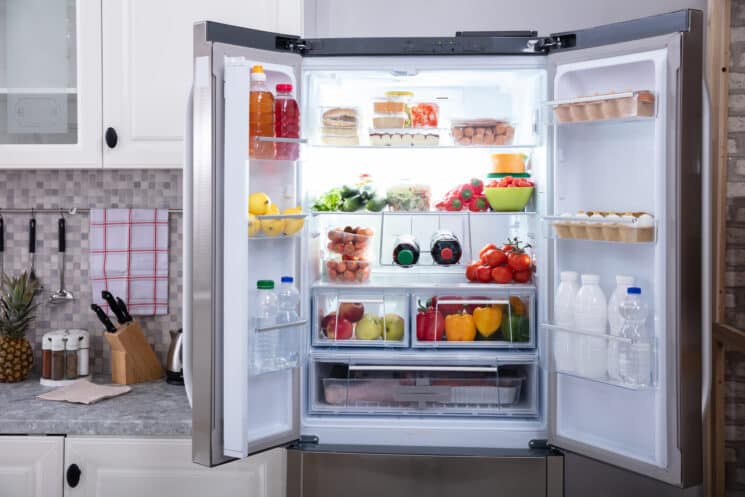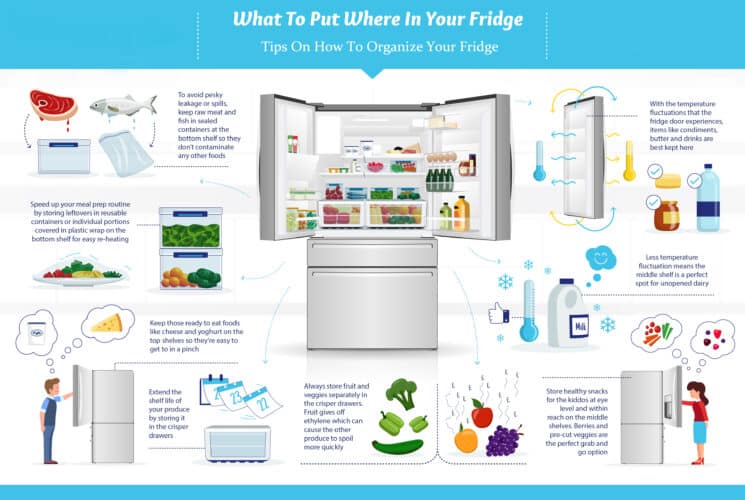Fridge Organization Guide
Learn how to store food in your refrigerator the way the pros do it so that you use the food you have, keep it safe to eat and throw a lot less away!

General Refrigerated Food Storage Safety Tips:
- Check your refrigerator’s temperature. Keep your refrigerator below 40 degrees Fahrenheit. Keep a thermometer in your refrigerator to ensure that it remains at the desired temperature.
- Organize. Keep your refrigerator organized into different zones to allow you to quickly find and re-shelve items. Designate the following zones in your refrigerator and label them: dairy, snacks, condiments, leftovers, meal prep, extras, and drawers for fruits and vegetables. This way, when people put things away in your fridge, they can easily identify the zones and keep it organized. For more information about organizing your refrigerator, go to the Super Healthy Kids Facebook video page and scroll to find the Fridge Tour and How to Organize your Fridge video.
- Put a date on things. We all, including myself, feel like we’ll remember when we put something into the refrigerator. But with everything else on our minds, it’s certainly easy to forget when we put the cooked chicken into the refrigerator or when we opened the jar of roasted red bell peppers. So add a label with a date on it so that no guessing is required.
- Put leftovers in clear containers. You are much more likely to use and eat things when you can see what is in it. These are our favorite containers. They are airtight, clear and keep your food fresher longer!
- Clean out your fridge weekly. Clean spills immediately with hot soapy water and rinse. Once a week, throw out perishable foods that should no longer be eaten. With the exception of a few foods, fresh, cooked and open foods should not be kept in the refrigerator longer than four to seven days. If you feel that you can’t use the food that quickly, consider freezing unused portions. Avoid using cleaners, solvent cleaning agents, and abrasives that could give a chemical taste to food or ice cubes.
- If in doubt, throw it out. You cannot smell, taste or see many harmful organisms in foods that may cause food-borne illnesses. This means that a food that you shouldn’t eat may look, smell, and taste okay. Therefore, if you aren’t sure that a food has been stored safely, toss it.
How to Store Specific Types of Foods:

Meat
- Packages of raw meat, poultry or fish should be kept in sealed bags or in a dish to catch any liquid that could drip.
- Ideally, you should defrost meat, poultry and fish in the refrigerator, and keep it in sealed bags or in a dish to catch any liquid that could drip.
- If possible, keep raw meat, poultry and fish on the lowest shelf of the refrigerator to keep from contaminating other foods.
- Use raw meat, poultry and fish within a couple of days, and do not use if it has an odor or if it is slimy or sticky. Also do not use it if it has discoloration.
- Cooked pieces of meat, poultry or fish as well as leftover casseroles containing cooked meat, poultry and fish should be used within two to three days.
- Leftover soups and stews with cooked meat, poultry or fish should also be used in two to three days.
Eggs
- Keep eggs in the original egg carton to keep them fresh longer and store them in the main body of the refrigerator to maintain a constant cold temperature.
- Use fresh eggs that are in their shell within three to five weeks.
- If your recipe calls for room temperature eggs, the maximum amount of time that you should leave the egg out of the refrigerator is two hours. (Tip: If a recipe calls for eggs at room temperature, immerse them in warm water for a few minutes.)
- For leftovers including eggs, refrigerate promptly, thoroughly reheat leftovers, and eat within two to three days.
- Leftover raw yolks or whites should be refrigerated immediately and used within two to four days.
- Refrigerate hard cooked eggs and use within one week of cooking.
- Foodsafety.gov has an excellent egg storage chart.
Dairy
- Store milk and other dairy products in the main body of the refrigerator.
- Use all milk within one week of opening regardless of the “sell by” date. It is good for one to five days beyond the “sell by” date.
- Hard cheeses that are tightly wrapped should last for three to four weeks in the refrigerator after opening.
- Processed cheese spread that is open should be used within three to four weeks.
- Opened cream cheese can last for two weeks, whereas open ricotta and cottage cheese last for about one week.
- Yogurt that is kept well covered can be used for seven to ten days beyond the “sell by” date.
- Sour cream is good for two weeks once it is opened.
- Use half and half, creams, and sour cream within one to five days of the “sell by” date.
- Butter can be stored in the refrigerator for up to two weeks. Once you open a stick of butter, wrap it or store it in tightly covered containers.
- Clemson Cooperative Extension has a chart listing safe cold storage times for milk and dairy.
Fruits and Vegetables
- Refrigerate all produce that is precut or pealed.
- Keep refrigerated fruits and vegetables in perforated plastic bags in the produce drawers of your refrigerator. To make your own perforated bag, make about 20 pin holes per medium sized bag.
- Keep fruits and vegetables separate from each other to reduce the detrimental effects of ethylene gas, produced by the fruits, on the vegetables.
- Wash fruits and vegetables just before use instead of prior to refrigerating.
- Opened canned fruit can be stored in the refrigerator for up to a week in a covered glass dish.
- Opened canned vegetables can be stored in the refrigerator for two-three days in a covered glass dish.
- For vegetable storage tips, click here.
- For fruit storage tips
By implementing just a few quick habits, you can keep your fridge clean, usable and throw a lot less food away!

Natalie Monson
I'm a registered dietitian, mom of 4, avid lover of food and strong promoter of healthy habits. Here you will find lots of delicious recipes full of fruits and veggies, tips for getting your kids to eat better and become intuitive eaters and lots of resources for feeding your family.
Learn More about Natalie